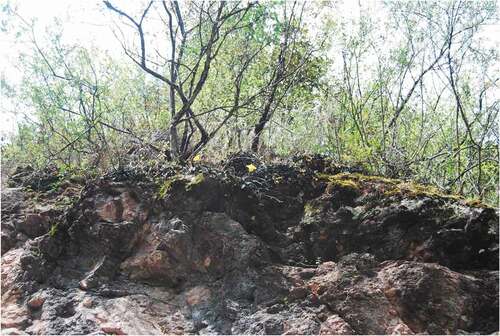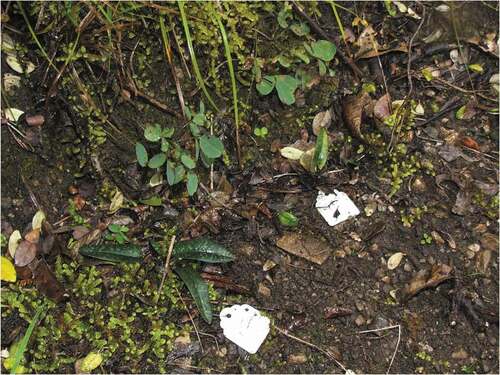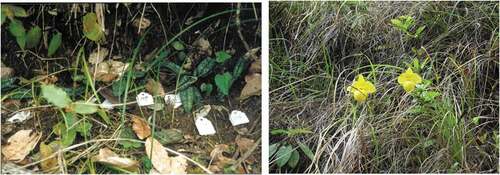ABSTRACT
Paphiopedilum armeniacum is a rare and endangered lady’s slipper orchid in China. It is distributed around the mid-elevations of the Nu Mountains in southwest China. Due to over-harvest, habitat loss, and degradation, wild populations of P. armeniacum has declined drastically. A combination of approaches involving biotechnology, habitat restoration, and interspecific relationship reconstruction was used to carry out the reintroduction of the species. Integrated conservation program for this species included in-situ protection, ex-situ conservation, and reintroduction, which helped to rebuild a harmonious relationship between local farmers and P. armeniacum. The sustainable utilization of native plant resources in poor areas can promote regional sustainable development which is compatible with species protection.
Paphiopedilum armeniacum (Orchidaceae) is a critically endangered orchid whose endangerment is closely linked to the international orchid trade
P. armeniacum is distributed in Baoshan, Gongshan, Fugong, Yunlong, Lanping and Lushui counties in western Yunnan, China, as well as in neighboring Myanmar. It has been over-harvested due to its high ornamental value (). Habitat loss and degradation have also contributed to the drastic decline of wild populations of P. armeniacum (Liu et al. Citation2006) (). It is classified as “Critically Endangered” (CR) on the Red list of China and that of the IUCN. The species is also on the List of China’s Plant Species with Extremely Small Populations and the Appendix I of the Convention on International Trade in Endangered Species of Wild Fauna and Flora (CITES) (Chen and Ji Citation2000).
Opportunities exist for effective in-site conservation of P. armeniacum
This orchid species is mainly found in the mid-elevations (1400–2250 m) of the Nu Mountains in small populations, in a range of habitat types including forest, bush, and limestone surface. The diverse habitats in which P. armeniacum can be found indicate that this species can adapt to a range of environmental conditions, including possibly harsh ones (). In its natural habitat, the species has a flowering rate of 7.39% ± 1.02% and a fruit set rate (from flowering individuals) of 32.23% ± 12.08% (Liu et al. Citation2006). It can reproduce asexually by tillers and rhizomes. Seeds can also germinate in situ and can complete their full life cycle. Namely, the orchid is known to be able to persist and thrive in natural habitats if left alone ().
However, strong ability to thrive alone is not enough for the species’ recovery. Reducing overharvesting behavior, as well as restoration of habitat and population is needed. To this end, the local government carried out local poverty alleviation which included measures such as relocation of willing villagers and agroforestry development during 2011–2020. Villager relocations freed up some habitats for P. armeniacum reintroduction while planting economically valuable plants under the forests increased farmers’ income rapidly, which in turn reduced overharvest behavior of rare orchids gradually (Wu Citation2020). These government interventions and the species’ own thriving ability have allowed the in-situ protection of P. armeniacum to be improved greatly.
Ex-situ conservation is aided by successful reproduction of P. armeniacum
One hundred and thirty individuals from eight populations that cover considerable phenotypic diversity were collected and transferred in 2000 to the National Orchid Conservation Center of China in Shenzhen (hereafter referred to as the Orchid Center) for ex-situ conservation. Most individuals there flowered normally and fruited after artificial pollination (). Tissue culture technique proved highly successful in enabling the seeds of P. armeniacum to germinate and develop into seedlings (). In total, 500 seedlings of P. armeniacum were generated at the Orchid Center. The Orchid Center also developed procedures for commercialized cultivation to promote species conservation and sustainable utilization (Ren Citation2020), which can help to alleviate pressure on wild harvesting.
Reintroduction of the P. armeniacum in pilot project achieved notable success
One hundred and sixty adult-size plants generated from seedlings produced at the Orchid Center were reintroduced into eight selected sites where the species was formerly found. Habitat restoration was carried out during reintroduction (). In the first year (2004), survival rate of the reintroduced plants was 38.13% ± 13.91%, and the blooming rate of the living genets was 14.38% ± 9.16% (Liu et al. Citation2006). The blooming ramets set fruit normally, at an average rate of 35.83% ± 30.31% (Liu et al. Citation2006). The fruiting rates of the reintroduced plants were not significantly different from that of the wild ones (32.23% ± 12.08%) (Liu et al. Citation2006) and most of living genets generated offsprings (). As shown in (left) and , associated species, including other orchids, mosses, and ferns, were planted around P. armeniacum individuals to reconstruct interspecific relationship. The method of habitat reconstruction in which species associations were reestablished has achieved good results in ex-situ conservation, as well as in in-situ reintroduction (Mou Citation2012). This indicates a successful reintroduction using a combination of approaches involving plants generated from tissue cultural technique, habitat restoration and interspecific relationship reconstruction.
Conclusions
For successful conservation of rare and endangered plants such as P. armeniacum in economically poor areas that have suffered historical and ongoing habitat destruction, a combined measures including local livelihood creation, in-situ protection, ex-situ conservation, and reintroduction should be implemented simultaneously. At the same time, commercial breeding using biotechnology technique can be carried out to meet the market demand for the traded orchids, and in turn break the vicious circle of poverty, excessive collection, resource depletion, and habitat degradation. The case of P. armeniacum demonstrates that the conservation of endangered plants, particularly from the threat of overexploitation, is achievable through integrated conservation strategies aided by science, technology, and government social programs. It can achieve sustainable utilization of threatened native plant resources while protect the species from over exploitation, which promotes regional sustainable development.
Photo 2. Landscape of the Nu mountains where P. armeniacum is found in the wild. Widespread anthropogenic disturbance can be seen. Photographer: Li-Jun Chen
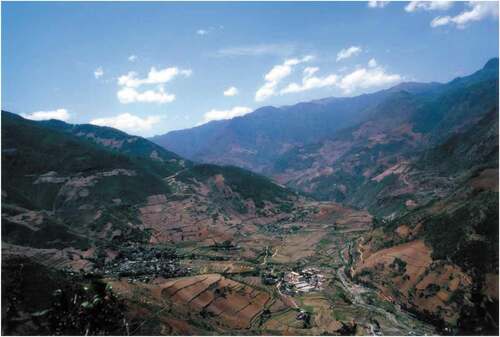
Photo 4. Well-growing individuals of P. armeniacum in natural habitat without interference. Photographer: Da-Peng Yu
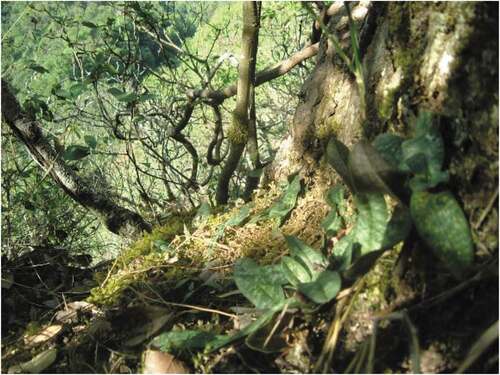
Photo 5. Ex-situ conserved P. armeniacum in the garden of the National Orchid Conservation Center of China. Photographer: Wen-Hui Rao (left), Mei-Na Wang (right)

Photo 6. The offsprings of P. armeniacum transplanted from the wild to the National Orchid Conservation Center of China. Photographer: Wen-Hui Rao
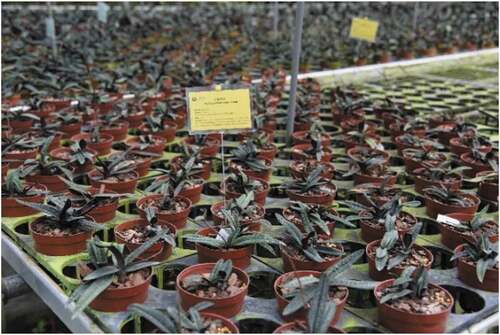
Disclosure statement
No potential conflict of interest was reported by the authors.
Additional information
Funding
References
- Chen, X. Q., and Z. H. Ji. 2000. The Orchids of China. Beijing: China Forestry Publishing House. (in Chinese).
- Liu, Z. J., K. W. Liu, L. J. Chen, S. P. Lei, L. Q. Li, X. C. Shi, and L. Q. Huang. 2006. “Conservation Ecology of Endangered Species Paphiopedilum armeniacum (Orchidaceae).” Acta Ecologica Sinica 26: 2791–5. (in Chinese). doi:https://doi.org/10.1016/S1872-2032(06)60043-7.
- Mou, Z. 2012. “Study on the Nutritional Physiology and Reproduction Characteristics of Paphiopedilum armeniacum.” PhD thesis, University of Chinese Academy of Sciences, Beijing. (in Chinese).
- Ren, H. 2020. Conservation and Reintroduction of Rare and Endangered Plants in China. Singapore: Springer.
- Wu, G. 2020. “Research on Urbanization of Poor Population Relocated by 100,000 in Nujiang of the Lisu Autonomous Prefecture.” Master Thesis, Yunnan University of Finance and Economics, Kunming. (in Chinese).


